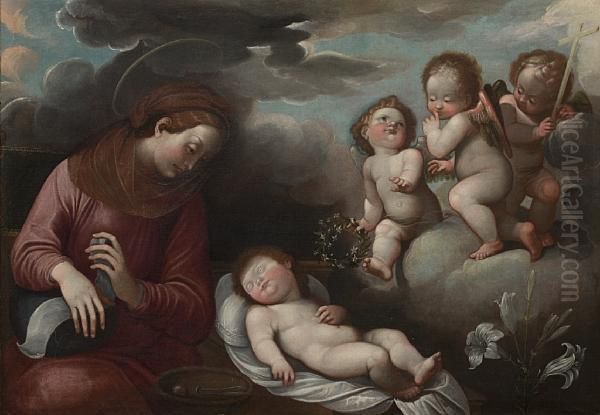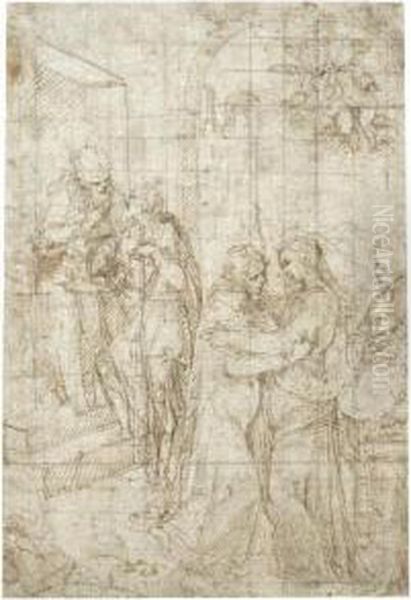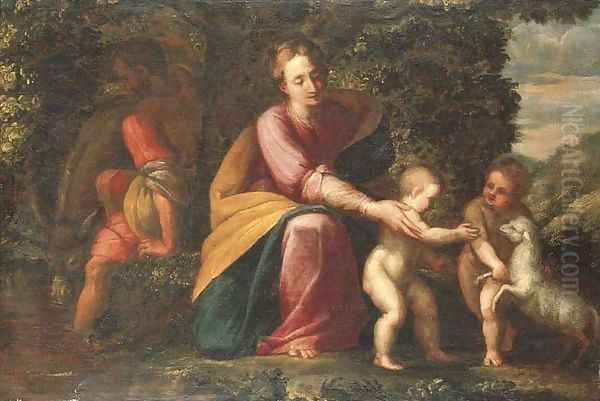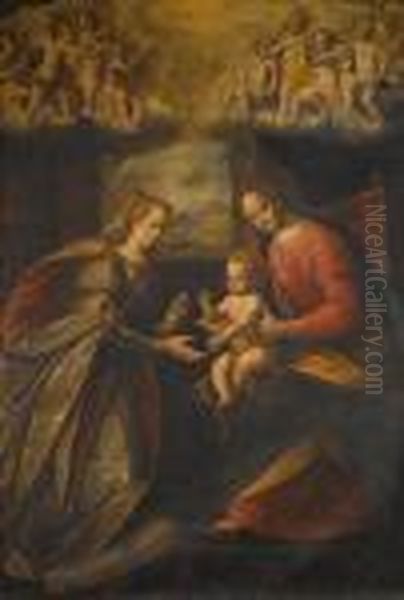Guglielmo Caccia, widely known by his moniker "Il Moncalvo," stands as a pivotal figure in the artistic landscape of Piedmont during the late 16th and early 17th centuries. Born in Montabone in 1568, his profound connection with the town of Moncalvo, where he resided for a significant portion of his life and career, earned him this enduring nickname. Caccia's artistic contributions, primarily in the realm of religious painting, positioned him as one of the most significant painters of his era in the region, leaving an indelible mark on the sacred art of Northern Italy. His prolific output and distinctive style bridged the late Mannerist tendencies with the burgeoning Baroque, making his work a fascinating study of artistic transition and regional identity.
Early Life and Artistic Formation
Guglielmo Caccia's journey into the world of art began in Montabone, a small commune in the province of Asti. While details of his earliest training are somewhat sparse, it is understood that his father, Ambrogio Oliva, was also a painter, suggesting an initial immersion in an artistic environment from a young age. It is likely that Caccia received his foundational instruction within his father's workshop, a common practice for aspiring artists of the period.
His formative years were significantly shaped by the artistic currents prevalent in Piedmont and neighboring Lombardy. The towering figures of the Piedmontese Renaissance, notably Gaudenzio Ferrari and his follower Bernardino Lanino, exerted a considerable influence on Caccia's developing style. The expressive intensity, rich coloration, and narrative clarity found in their works provided a strong local tradition upon which Caccia could build. He is known to have spent time in Vercelli, a city where the legacies of Ferrari and Lanino were particularly potent, and this experience undoubtedly deepened his understanding of their artistic language. The impact of these masters is especially discernible in Caccia's early fresco cycles, such as those undertaken for the Sacro Monte di Crea, where the devotional spirit and compositional strategies echo the work of his predecessors.

Caccia's artistic education was not solely confined to regional influences. The broader artistic developments emanating from major Italian centers, particularly Rome and Bologna, also played a role in shaping his mature style. The Counter-Reformation's call for art that was clear, persuasive, and emotionally engaging resonated deeply in his work. While he may not have travelled extensively to these centers himself in his early years, the circulation of prints, drawings, and even paintings, as well as the movement of artists, ensured that these stylistic trends permeated even regional artistic hubs like those in Piedmont.
His early career saw him active in Novara before moving to Vercelli and then Casale Monferrato. This period was crucial for honing his skills in both oil painting and fresco, techniques he would master and employ throughout his career. The demand for religious art was high, fueled by the Church's efforts to reinvigorate faith in the wake of the Protestant Reformation, and Caccia quickly established himself as a capable and reliable artist for such commissions.
The Moncalvo Period: Maturity and Major Commissions
In 1593, Guglielmo Caccia made a decisive move, settling in Moncalvo. This town would become his primary base of operations and so intrinsically linked to his identity that he became known as "Il Moncalvo." It was from here that his reputation solidified, and he undertook numerous significant commissions that spread his fame across Piedmont and beyond. His workshop in Moncalvo became a bustling center of artistic production.
One of his most extensive and celebrated undertakings was the decoration of the Convent of the Holy Cross (Convento di Santa Croce) in Casale Monferrato. Here, Caccia executed over thirty frescoes, a monumental task that showcased his skill in large-scale narrative compositions and his ability to manage complex decorative schemes. These works, rich in religious iconography and imbued with a devout sensibility, were critical in establishing him as a leading painter of sacred subjects.
His talents were sought after in major urban centers as well. In Pavia, he received important commissions, including two significant altarpieces for the Church of Santa Maria di Canepanova in 1614. These depicted Saint Charles Borromeo and Blessed Alexander Sauli, both prominent figures of the Catholic Renewal. The commission for these works came directly from Giovanni Ambrosio Mazzanti, the church's superintendent, indicating Caccia's growing prestige. Further works for Pavia included altarpieces of David and Abishag and Jacob and Zilpah, which were reportedly executed in Milan and transported to Pavia in the autumn of 1616.

Milan, a major artistic and religious hub, also featured prominently in Caccia's career. He produced numerous works for Milanese churches, including a notable piece, Angels and Shepherds Making Music, for the Church of Sant'Antonio Abate, completed around 1613. His presence in Milan would have exposed him to the influential work of artists like Giovanni Battista Crespi (Il Cerano), Giulio Cesare Procaccini, and Pier Francesco Mazzucchelli (Il Morazzone), who were key proponents of the Lombard Baroque style.
Turin, the ducal capital of Savoy, was another important center for Caccia's activities. He worked for the ducal court, a testament to his high standing. A significant commission involved a Madonna and Child (1618-1619) for the chapel of Duke Charles Emmanuel I of Savoy. This project saw him collaborate with Federico Zuccari, a prominent Roman Mannerist painter, highlighting Caccia's ability to work alongside artists of national renown. He also contributed to the decoration of the Church of Sant'Antonio Abate in Turin, with works such as The Silent Life of St. Anthony and The Penance of St. Peter.
Artistic Style and Influences
Guglielmo Caccia's artistic style is a compelling synthesis of various influences, rooted in the Piedmontese tradition but responsive to broader Italian Baroque developments. His work is characterized by a profound religious sentiment, typical of the Counter-Reformation era, which demanded art that could instruct, inspire devotion, and move the faithful.
His early works clearly show the imprint of Gaudenzio Ferrari and Bernardino Lanino, particularly in their compositional structures and the gentle, devout expressions of his figures. However, Caccia's style evolved, absorbing elements from the Roman and Bolognese schools. The influence of the Carracci, particularly their emphasis on clarity, naturalism, and emotional directness, can be discerned in his more mature works. While not as dramatically tenebrist as Caravaggio or his followers, Caccia's handling of light and shadow became more sophisticated over time, lending volume and presence to his figures.
Caccia was proficient in both oil painting and fresco. His oil paintings are often characterized by a rich, warm palette, with a preference for harmonious color combinations. He demonstrated a fine touch in rendering textures and details, from the soft folds of drapery to the delicate features of his saints and Madonnas. His figures, while often idealized in accordance with Baroque aesthetics, possess a tangible humanity.

In his frescoes, Caccia displayed a remarkable ability for large-scale narrative and decorative schemes. His compositions are typically well-balanced, with figures arranged to convey the story clearly and effectively. He adapted his style to the demands of mural painting, often employing lighter, more luminous colors suited to the medium and the architectural settings.
A notable characteristic of Caccia's art is its gentle, almost sweet devotional quality. Even in scenes of martyrdom or intense religious experience, there is often an underlying tenderness and grace. This distinguishes his work from some of the more overtly dramatic or theatrical tendencies within the Baroque. His style can be seen as a regional interpretation of the Baroque, one that retained a certain Lombard and Piedmontese restraint and intimacy.
Over his career, there is a discernible shift from a more robust, early Baroque manner towards a softer, more delicate, and refined style in his later works. This evolution reflects his ongoing engagement with contemporary artistic trends and his personal artistic development. His ability to convey deep religious feeling without resorting to excessive melodrama was a hallmark of his mature style.
Key Works and Their Significance
Guglielmo Caccia's oeuvre is extensive, with many of his most important works still adorning the churches and religious institutions for which they were created. Several pieces stand out for their artistic quality and historical importance.
The frescoes in the Convent of the Holy Cross (Santa Croce) in Casale Monferrato represent one of his most ambitious projects. This cycle, comprising over thirty individual scenes, allowed Caccia to demonstrate his mastery of complex narrative and his ability to create a cohesive decorative program. These frescoes are vital for understanding his approach to large-scale mural painting and his interpretation of sacred themes.
The altarpiece of the Madonna and Child with Saints (1618-1619), created for the chapel of Duke Charles Emmanuel I of Savoy in Turin, is another significant work. His collaboration on this piece with Federico Zuccari, an artist of national stature, underscores Caccia's high reputation. The painting would have been a prestigious commission, reflecting the Duke's patronage and Caccia's role within the courtly artistic sphere.

_The Wedding at Cana_ (1623-1625), now housed in the Convent of Saint Augustine in Aosta, is a masterful example of his oil painting technique. This large canvas showcases his skill in composing multi-figure scenes, his rich use of color, and his ability to imbue a biblical narrative with life and vibrancy. The depiction of the figures, their interactions, and the overall festive yet sacred atmosphere are characteristic of his mature style.
His works for the Church of Santa Maria di Canepanova in Pavia, specifically the altarpieces of Saint Charles Borromeo and Blessed Alexander Sauli (1614), are important examples of his contributions to the iconography of Counter-Reformation saints. These paintings served to promote the cult of these influential figures and demonstrate Caccia's ability to create powerful devotional images.
The early painting of _St. Roch and St. Sebastian_ (c. 1585), located in the Church of San Pietro in Ciel d'Oro, Pavia, provides insight into his formative style, likely still showing strong connections to the Piedmontese tradition of Gaudenzio Ferrari and Bernardino Lanino, while also hinting at the developing Baroque sensibility.
Other notable works include the decorations for the Church of Sant'Alberto in Casale Monferrato, featuring The Descent of the Holy Spirit and The Martyrdom of Saints, and his contributions to the Church of Sant'Antonio Abate in Milan, such as Angels and Shepherds Making Music (1613). The unfinished paintings of St. George on Horseback and St. Maurice are also intriguing, reportedly showcasing his skill in rendering landscapes with fine detail, an aspect not always at the forefront of his large religious commissions.
Collaborations and Contemporaries
Guglielmo Caccia's career unfolded during a vibrant period for art in Northern Italy. He was not an isolated figure but part of a network of artists, patrons, and religious institutions. His collaborations and interactions with contemporary painters are noteworthy.
His most prominent documented collaboration was with Federico Zuccari (c. 1540/1541 – 1609) on the altarpiece for Duke Charles Emmanuel I's chapel in Turin. Zuccari was a leading figure of late Mannerism, with a career that spanned Rome, Florence, and even international courts. Working alongside such an established artist would have been a significant experience for Caccia, likely fostering an exchange of ideas and techniques.
Between 1605 and 1607, Caccia is recorded as having worked with Fede Galizia (c. 1578 – c. 1630) on the decoration of Duke Charles Emmanuel I's palace in Turin. Galizia, a Milanese painter, was one of the earliest female artists in Italy to achieve professional success, known for her portraits, religious subjects, and pioneering still lifes. This collaboration points to the interconnected artistic circles of Piedmont and Lombardy.
The artistic environment of Lombardy, particularly Milan, was rich with talent during Caccia's lifetime. Figures such as Giovanni Battista Crespi, known as Il Cerano (c. 1573–1632), Giulio Cesare Procaccini (1574–1625), and his brother Camillo Procaccini (c. 1561–1629), along with Pier Francesco Mazzucchelli, known as Il Morazzone (1573–1626), were shaping the distinctive Lombard Baroque style. This style was characterized by intense emotion, dramatic lighting, and a rich, often somber palette. While Caccia's style maintained its own Piedmontese inflections, he would have undoubtedly been aware of, and likely influenced by, these powerful artistic currents, especially during his work in Milan.
Other notable painters active in the region included Tanzio da Varallo (c. 1575/1580 – c. 1632/1633), whose work showed a more rugged naturalism, and Daniele Crespi (1598–1630), a younger artist whose career was tragically cut short by the plague but who produced deeply moving religious works. The influence of earlier masters like Antonio Campi and his brothers from Cremona also lingered in the region. Furthermore, the broader impact of Caravaggio's revolutionary naturalism, though perhaps indirectly, was beginning to be felt across Italy. Caccia's art, while generally more classical and less overtly dramatic than that of some of these contemporaries, participated in the same overarching cultural and religious climate of the Counter-Reformation. His connections also extended to artists like Giovanni Mauro della Rovere, known as Il Fiammenghino (1575-1640), who was active in Milan.
The Sacred and the Secular: Themes and Patronage
The vast majority of Guglielmo Caccia's artistic output was dedicated to sacred themes, a direct reflection of the spiritual and cultural priorities of the Counter-Reformation. The Council of Trent (1545-1563) had emphasized the role of art as a tool for religious instruction and inspiration, leading to a surge in demand for paintings and frescoes that could clearly convey Catholic doctrine and stir piety among the faithful. Caccia's work perfectly aligned with these objectives.
His paintings frequently depicted scenes from the life of Christ, the Virgin Mary, and numerous saints. Altarpieces were a significant part of his production, designed to be the focal point of chapels and inspire devotion during Mass. He painted numerous Madonnas, images of the Crucifixion, Adorations, and scenes of martyrdom. The cult of saints, particularly those who embodied the ideals of the Catholic Renewal like Saint Charles Borromeo, was actively promoted, and Caccia contributed to this through powerful and dignified portrayals.
His patrons were primarily ecclesiastical institutions – churches, convents, monasteries, and confraternities. These bodies commissioned extensive fresco cycles to adorn their chapels and refectories, as well as individual altarpieces and devotional paintings. The sheer volume of his work for such patrons across Piedmont and Lombardy attests to his reputation for skill, reliability, and orthodox interpretation of religious subjects.
Beyond ecclesiastical patronage, Caccia also worked for secular rulers, most notably Duke Charles Emmanuel I of Savoy in Turin. Such courtly commissions, like the altarpiece for the ducal chapel, were prestigious and indicative of an artist's high standing. While these works were also often religious in theme, the context of ducal patronage added another layer of significance, aligning the ruler's piety with artistic excellence. There is less evidence of Caccia engaging extensively in purely secular genres like portraiture or mythology, though his unfinished St. George and St. Maurice reportedly included detailed landscape elements, suggesting a broader range of interests. His primary focus, however, remained firmly rooted in sacred art.
The Legacy of Il Moncalvo
Guglielmo Caccia's death in Moncalvo in 1625 marked the end of a prolific and influential career. He left behind a vast body of work that significantly shaped the religious art of Piedmont in the early 17th century. His influence extended beyond his lifetime, primarily through his workshop and, most notably, through his daughter.
Orsola Maddalena Caccia (1596–1676) was not only Guglielmo's daughter but also his pupil. She became a remarkable artist in her own right, specializing in religious paintings and, uniquely for a nun at that time, still lifes. After entering the Ursuline convent in Bianzè, and later helping to found a new Ursuline convent in Moncalvo, Orsola Maddalena continued to paint, managing her father's workshop and using her artistic talents to support her religious community. Many of her father's drawings and studio materials passed to her, and she skillfully continued his artistic tradition, adapting his style with her own delicate sensibility. Her success as a female artist, particularly one working from within a convent, is a significant aspect of Caccia's legacy. She ensured the continuation of his workshop's output and helped to preserve and disseminate his artistic heritage.
Caccia's style, with its blend of Piedmontese tradition and broader Baroque influences, provided a model for other local artists. His workshop likely trained a number of assistants and followers who helped propagate his manner. The sheer number of his works in churches across the region meant that his paintings were constantly visible, serving as exemplars for subsequent generations.
While some of the more dramatic and dynamic aspects of the High Baroque, as practiced in Rome or by some of his Lombard contemporaries, were not the defining features of Caccia's art, his contribution was nonetheless vital. He provided a deeply felt, accessible, and artistically accomplished visual language for the Counter-Reformation in his region. His paintings were celebrated for their devotional sincerity, their harmonious compositions, and their pleasing coloration.
Unresolved Aspects and Scholarly Interest
Despite Guglielmo Caccia's significance in his time and the considerable body of work he left, certain aspects of his life and career remain subjects of ongoing scholarly investigation. The precise chronology of some of his works, the full extent of his travels, and the specific nature of his interactions with all contemporary artists are not always definitively established.
For instance, while his activity in Milan and Pavia is documented through commissions, the exact duration and frequency of his stays in these cities, and the full list of his patrons and contacts there, continue to be refined by art historians. The attribution of certain works can also be complex. As with many prolific artists of the period who ran active workshops, distinguishing between the master's hand, workshop production, and the work of close followers or family members like Orsola Maddalena can sometimes be challenging. Some of his paintings may have been misattributed over time, or their authorship debated.
The influence of specific artists on Caccia, beyond the well-established connections to Gaudenzio Ferrari, Bernardino Lanino, and the Zuccari collaboration, is another area of interest. Understanding how he absorbed and reinterpreted the stylistic innovations emanating from Rome, Bologna, and Milan without extensive, documented travel to all these centers in his youth relies on careful analysis of his works and the artistic environment of Piedmont.
His role as a teacher, particularly to his daughter Orsola Maddalena, is well-recognized, but the broader impact of his workshop on other Piedmontese artists is a topic that benefits from continued research. The discovery of new documents, contracts, or preparatory drawings can shed further light on his working methods, his patrons, and his artistic relationships.
The religious and charitable dimensions of his life, including his support for religious institutions and his daughter's convent (which she, in turn, supported by selling his and her own art), add another layer to his biography that invites exploration. These aspects paint a picture of an artist deeply embedded in the spiritual and social fabric of his time.
Conclusion
Guglielmo Caccia, "Il Moncalvo," was a cornerstone of Piedmontese painting in the transition from the late 16th to the early 17th century. His prolific output, primarily dedicated to religious themes, fulfilled the spiritual needs of the Counter-Reformation era, providing churches and patrons with artworks that were both devoutly inspiring and artistically accomplished. Rooted in the local traditions of masters like Gaudenzio Ferrari, Caccia's style evolved to incorporate the clarity and emotional engagement characteristic of the early Baroque, influenced by developments in Rome, Bologna, and nearby Lombardy.
His extensive fresco cycles, numerous altarpieces, and devotional paintings are found throughout Piedmont and beyond, testament to a career marked by consistent demand and high regard. From the grand decorations in Casale Monferrato to significant commissions in Pavia, Milan, and the ducal court of Turin, Caccia demonstrated a versatile command of both oil and fresco. His collaborations with artists like Federico Zuccari and his position within a network of influential contemporaries such as Il Cerano, Morazzone, and the Procaccini brothers situate him firmly within the vibrant artistic milieu of Northern Italy.
Beyond his own considerable achievements, his legacy was uniquely perpetuated through his daughter, Orsola Maddalena Caccia, an accomplished artist who continued his workshop and artistic tradition from within her convent. Guglielmo Caccia's art, characterized by its gentle piety, harmonious compositions, and warm palette, remains a vital expression of regional Baroque identity and a significant chapter in the history of Italian sacred art.